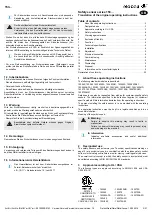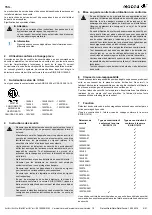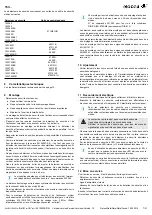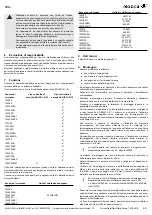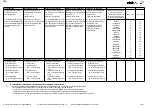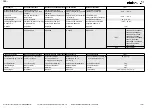
Art.-Nr./Art. No./Réf./N° art/N° art.: 9010005B01M
Version/Version/Version/Versione/Versión: 1.0
Datum/Date/Date/Data/Fecha: 15.02.2016 5/21
153...
- Where possible, the safety sensor and actuator should not be mounted on
ferromagnetic material. Changes to the operating distances are to be
expected. A non-magnetic spacer with a thickness of at least 8 mm must be
used.
- The mounting distance between two safety sensor and actuator systems
must be at least 50 mm.
- Tightly fasten the safety sensor and actuator to the safety device.
- Only M4 flat head screws (e.g. M4 cylinder head screws ISO 4762) may be
used for mounting the safety sensor and actuator. Max. tightening torque
2.9 Nm. Screws made from non-ferromagnetic material (e.g. brass) must be
used.
- The safety sensor may only be mounted on an even surface as failure to do
so may lead to tension which could damage the safety sensor or alter the
operating distances.
- The connection cable of the safety sensor must be protected against me-
chanical damage.
- During the assembly process, the requirements according to EN 14119
should be taken into consideration.
- Consider the requirements of EN 60204-1 when mounting, in particular with
regard to appropriate laying. It is recommended to conceal the safety sensor
lead.
10 Adjustment
- Always test the correct functionality with one of the approved safety control
units.
- The specified operating distances (see Technical specifications) only apply
for mounting on non-ferromagnetic material and without consideration of
mounting and temperature tolerances if the safety sensor and actuator are
mounted in parallel and facing each other. Other layouts may lead to
deviating operating distances.
11 Electrical connection
- Electrical connection is permitted in voltage-free state only.
- Connect the safety sensor according to the specified wire colours or pin
assignment (see Technical specifications).
- Please ensure that the voltage does not fall below the required minimum
input voltage of the downstream safety processing unit. For that reason
observe the voltage drop at the safety sensor (series resistor) and in the
connection cable.
- The voltage drop for the internal LED circuit is to be considered additionally
for LED safety sensors (see technical specifications).
- For series connection of the safety sensors (verify approval in advance) their
respective NO paths must be connected in series and the respective NC
paths must be connected in parallel.
12 Commissioning
When commissioning, the following points must be ensured in advance:
- The safety sensor and actuator are positioned correctly and mounted in a
fixed position.
- The supply line is intact.
- There are no iron filings on the safety sensor and actuator.
The safety sensor and the connected control unit must then be tested for
correct functionality.
13 Maintenance
If the safety sensor is mounted and used correctly, no maintenance measures
are be necessary.
We recommend a visual and functional inspection carried out at regular
intervals:
- Check that the safety sensor and actuator are firmly seated.
- Inspect the connection cable for damage.
14 Dismantling
The safety sensor may only be dismantled in a voltage-free state.
15 Disposal
Dispose of packaging and used parts in accordance with the regulations of the
country in which the device is installed.
16 Information on the manufacturing date
Détecteur de sécurité 153...
Traduction de la notice d'utilisation d'origine
Table des matières
À propos de cette notice d'utilisation . . . . . . . . . . . . . . . . . . . . . . . . 5
Utilisation conforme à l'usage prévu . . . . . . . . . . . . . . . . . . . . . . . . 6
Autorisation selon UL / CSA. . . . . . . . . . . . . . . . . . . . . . . . . . . . . . . 6
Instructions de sécurité . . . . . . . . . . . . . . . . . . . . . . . . . . . . . . . . . . 6
Mise en garde contre toute utilisation non conforme . . . . . . . . . . . . 6
Clause de non-responsabilité. . . . . . . . . . . . . . . . . . . . . . . . . . . . . . 6
Caractéristiques techniques. . . . . . . . . . . . . . . . . . . . . . . . . . . . . . . 7
Ajustement . . . . . . . . . . . . . . . . . . . . . . . . . . . . . . . . . . . . . . . . . . . . 7
Raccordement électrique . . . . . . . . . . . . . . . . . . . . . . . . . . . . . . . . . 7
Mise en service . . . . . . . . . . . . . . . . . . . . . . . . . . . . . . . . . . . . . . . . 7
Maintenance. . . . . . . . . . . . . . . . . . . . . . . . . . . . . . . . . . . . . . . . . . . 8
Démontage. . . . . . . . . . . . . . . . . . . . . . . . . . . . . . . . . . . . . . . . . . . . 8
Informations relatives à la date de production . . . . . . . . . . . . . . . . . 8
Déclaration de conformité . . . . . . . . . . . . . . . . . . . . . . . . . . . . . . . . . . . . . 22
1
À propos de cette notice d'utilisation
Sont décrites les variantes des types de base suivants:
153260, 153262, 153262AFA, 153262A01, 153262S, 153262SA01,
153262SAFA, 153V62, 153V6201, 153V62S, 153V62A0D, 153V62SHD,
153270, 153270AA, 153270A0E, 153270S, 153270SA, 153270SA0D,
153270AW01
Les fiches techniques supplémentaires des détecteurs de sécurité sur mesure
peuvent être obtenues sur demande auprès de la Sté. elobau. Pour les types
sur mesure, les données de la fiche technique sont valables si ces dernières
sont différentes de celles mentionnées dans la notice d'utilisation.
Suitable washers for the safety sensor and magnet are available
from elobau under order number 350004.
For securing the locking screws against easy disassemble, Allen-
type locks made of PA are available from elobau:
Order number 351040 for cylinder head screws
DIN EN ISO 4762/M4 (previously DIN 912)
For safety sensors with male connectors, suitable cable sets and
connectors for assembly are directly available from elobau.
The control contact is not a safety contact.
It may not be incorporated into a safety circuit.
Use the control contact for non safety-relevant signal and control
functions only.
If several safety sensors with LED are used, the brightness of the
LEDs can decrease with an increasing number of closed safety
doors.
Damaged or faulty devices must be exchanged with original
replacement parts!
The manufacturing date can be seen on the safety sensor casing
in the form of "calendar week/year":
e.g. "19/11“ = calendar week 19 / year 2011
F



